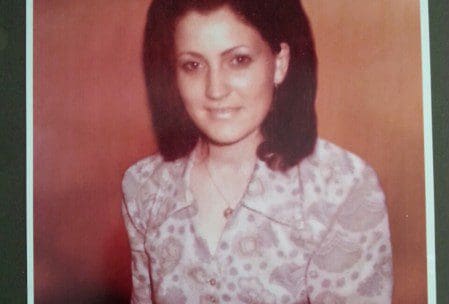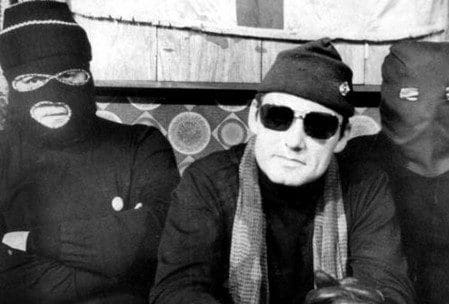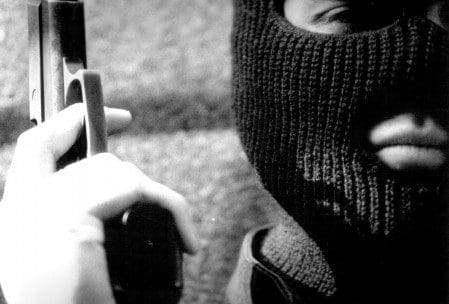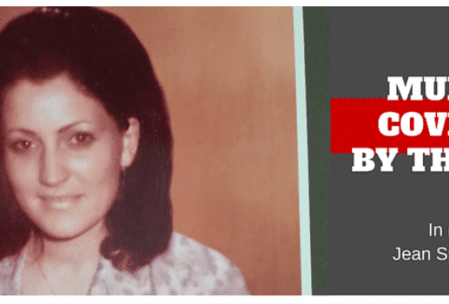Paper Trail has linked Britain’s Military Reaction Force (MRF) to multiple murders and attempted murders of civilians in Belfast in 1972.
Secret British military documents prove that the MRF was indeed guilty of a catalogue of murders and attempted murders of unarmed civilians – including teenagers – in Belfast between May and September 1972.
The archival evidence accounts for every single one of those listed by the Legacy Investigation Branch (LIB) of the Police Service of Northern Ireland (PSNI) when it launched Operation Everson, its inquiry into the Military Reaction Force, in December 2015.
Nevertheless, Paper Trail is investigating many more serious, unprovoked attacks on civilians, which LIB has not included in Operation Everson, including the shooting of several unarmed teenagers shot in separate incidents in North Belfast during the summer of 1972.
Our evidence also includes files discovered by our research colleague, James Kinchin-White, which proves that an undercover unit of the Kings Own Scottish Borderers led by then Lieutenant Julian “Tony” Ball shot the brothers, John and Gerry Conway, in April 1972.
To-date, the PSNI have failed to arrest any British soldiers for the attacks but Paper Trail understands that the police sent a file to the Public Prosecution Service (PPS) subsequent to us handing over our evidence to former Chief Constable Jon Boutcher whose team is investigating the murder of Jean Smyth-Campbell on June 8th 1972.
Files that we discovered prove that Jean was killed by the British Army and the Military Reaction Force claimed “a hit” in the same area.
Paper Trail Investigation
Jean’s family fought a historic battle in the courts against the PSNI and its failure to investigate the murder of Jean. In 2019, an Appeal Court in Belfast ruled that the PSNI’s Legacy Investigation Branch was not “practically independent” and could not offer an investigation sufficiently compliant with Article 2 of the European Convention on Human Rights.
The PSNI is fighting this ruling in the Supreme Court, re-traumatizing Jean’s family once more, but, in the meantime, has passed the investigation to former Chief Constable Jon Boutcher’s Operation Kenova team as a remedy for an independent investigation.
In December 2015, as PSNI forced Jean’s family to fight in court for an independent investigation, the PSNI’s Legacy Investigation Branch (LIB) launched an appeal for information relating to the MRF. The LIB did not include Jean’s murder in its list for investigation.
Jean’s family and Paper Trail considered this LIB inquiry as window-dressing at best and, at worst, a cynical ploy to delay a proper investigation into the criminal activities of the Military Reaction Force and the subsequent cover-ups by the British Army and Royal Ulster Constabulary.
Many other families do not believe that LIB is independent and can offer an Article 2-compliant investigation in any legacy investigation, especially those perpetrated by the British state or involving state agents/actors.
It is moot whether the failure of Operation Everson and the PSNI to arrest or convict any MRF killers is an indicator of this lack of independence.
On behalf of Jean’s family, therefore, Paper Trail researched the LIB’s list of incidents and can now prove which undercover British military unit perpetrated each attack on the unarmed civilians.
Individual MRF operatives are named in some of the files we have presented to Boutcher’s team including a Sergeant of the MRF who is named in at least 6 of the shootings.
Nevertheless, Paper Trail is only depicting small sections of these files below and redacting names of British Army MRF operatives as these legal cases are ongoing. Paper Trail continues to work closely with the families’ legal teams whilst it examines many other unclaimed murders and attempted murders.
Civilian witnesses, including the surviving victims, strongly refute the narrative of the British Army reports in these files below. In each case, the police found no trace of gunshot residue when it carried out tests on living and dead victims.
In some cases, not only has the British military refused to admit that its undercover units were involved, but also claimed at the time that the attacks were sectarian Loyalist shootings or Republican own-goals.
Operation Everson List
- 6th May 1972 – 18-year-old teenaged male shot on the Glen Road.
MRF patrol on the Glen Road allege it saw 3 gunmen (one with a rifle and two with pistols) at the back of Glenveagh Drive (not Glenmore). They claim “1 definite hit” and further allege that a gunman fired two shots at the patrol.
A sergeant of the MRF patrol is named but we have redacted it.


- 7th May 1972 – 15-year-old boy shot outside a disco at Oliver Plunkett School on the Glen Road
2-car MRF patrol on Glen Road allege that they were fired upon, their cars were hit and an MRF operative was injured. They claimed 2 hits in return. The 15-year old had left a local disco when he was shot from a passing car. No intelligence trace (NT) linked the boy to paramilitarism or criminality.



- 9th May – Van shot at on Kashmir Road
MRF (Vehicle C) alleged it was pursuing a hijacked vehicle and the occupant produced a weapon. The MRF Sergeant in charge of the unit – whose name we have redacted – fired 2 gunshots at the vehicle which hit the windscreen and the van swerved.

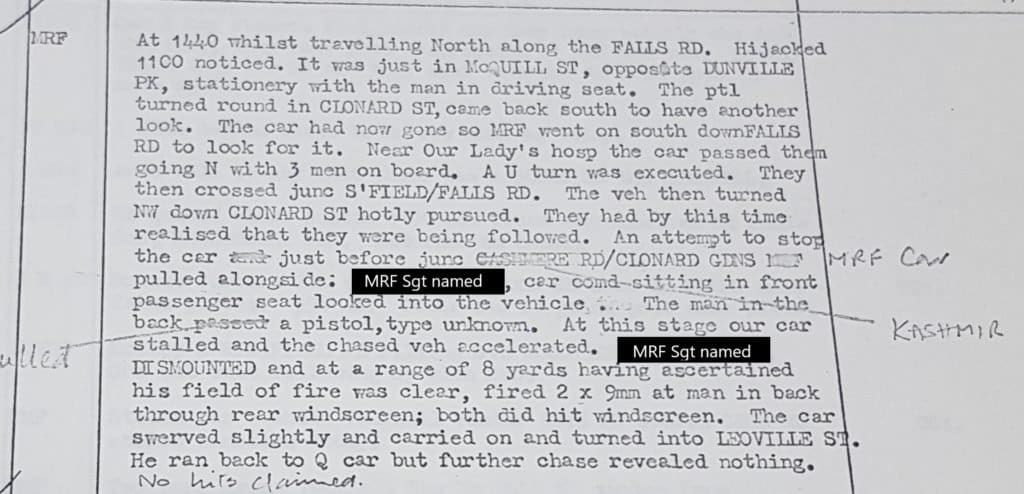
- 12/13th May 1972 – 18-year-old teenaged male shot in Slievegallion (plus another potential victim) around midnight
MRF (Vehicle G) alleges a high-velocity round was fired at them when it was passing a roadblock (manned by local people) and a car was backing away from it. MRF returned 13 rounds (8 from a sub-machine gun and 5 x 7.65 mm).
Makeshift barricades and vehicle checkpoints were manned by local people in communities across Belfast at this time as they feared paramilitary and/or British Army attacks.
MRF notes that an officer from 8 Brigade (which covered Derry and surrounding area and not Belfast) was “armed with a Walther pistol from MRF” so it would appear it was not standard issue to the officer as such.
Although MRF claimed no hits, an 18-year-old was admitted to hospital with a gunshot wound to the left arm. The victim reported he was getting out of a taxi at Slievegallion when he was shot from a passing car.
Later serials record another victim potentially shot during the same incident who is not included in the LIB’s list of victims within its inquiry. Interestingly too, the British Army alleged it discovered a loaded armalite close to the Slievegallion barrier and arrested the local men there including Ranger Louis Hammond who we now know subsequently was an MRF agent or “Fred”.



- 13th May 1972 – Patrick McVeigh killed and 4 males aged 18, 25, 25 and 41 in Riverdale Park
This incident occurred a short distance away from the above incident and within minutes.
MRF allege it fired upon 7 gunmen with 3 bursts of 4 submachine gun bullets and 6 from a 9mm pistol after MRF were fired upon. Again, this was a local vehicle check point. Five unarmed civilians were shot including Patrick McVeigh who was killed. No intelligence trace (NT) was found on Mr. McVeigh.


- 26th May 1972 – 34-year-old man shot in Silvio Street
MRF allege it had tailed a suspect vehicle and then gave chase. When it had stopped the vehicle, the MRF allege its operative had produced an identity card and the vehicle took off again. When it stopped the vehicle a second time, the MRF allege that two of the passengers in the back seat produced pistols and the MRF operative fired 1 bullet at the car as it again took off. Local people then accosted the MRF unit which had to be rescued by a uniformed patrol of the Royal Regiment of Wales after a police patrol allegedly refused to help it.
Each member of the MRF unit is named in these files but we have redacted them.



- 22nd June 1972 – shooting of 4 males aged 18, 19, 21 and 28 on the Glen Road
This incident on the Glen Road occurred at the same bus terminus as Jean Smyth-Campbell’s killing two weeks previously. It has been widely reported and written about, including by Paper Trail (? Paper Trail Pro Podcast) and Pat Finucane Centre.
The MRF shooter was named in court as Sgt. Clive Graham Williams and he used a non-standard issue Thompson submachine gun (used by the Irish Republican Army at the time). This gun belonged to Captain James Alistair McGregor, leader of the MRF at the time, who was also in the vehicle. The bullets for the gun came from RUC police stores.
The Paper Trail logs below allege that the MRF was fired upon by the civilians from the bus terminus and the MRF returned fire. 4 men were actually injured and lucky to survive.

Also included below for interest, is part of a Legal Defence Brief prepared for the court case against the MRF shooter in 1973 which was discovered originally by Justice for the Forgotten/Pat Finucane Centre. Neither Williams nor McGregor were prosecuted.

- 26th September 1972 – 18-year-old Daniel Rooney killed and his 18-year-old friend injured in St. James area
The related documents below were originally discovered by our research colleague, James Kinchin-White. Again, it alleges that the undercover unit was fired upon and it returned fire, injuring one teenager and killing another teenager, Daniel Rooney. Again, local witnesses denounced the allegations that the teenagers were armed or had fired on the unit.
This document does not name the MRF but affirms that the unit was recruited, deployed and controlled in the same way as the MRF at the same time.
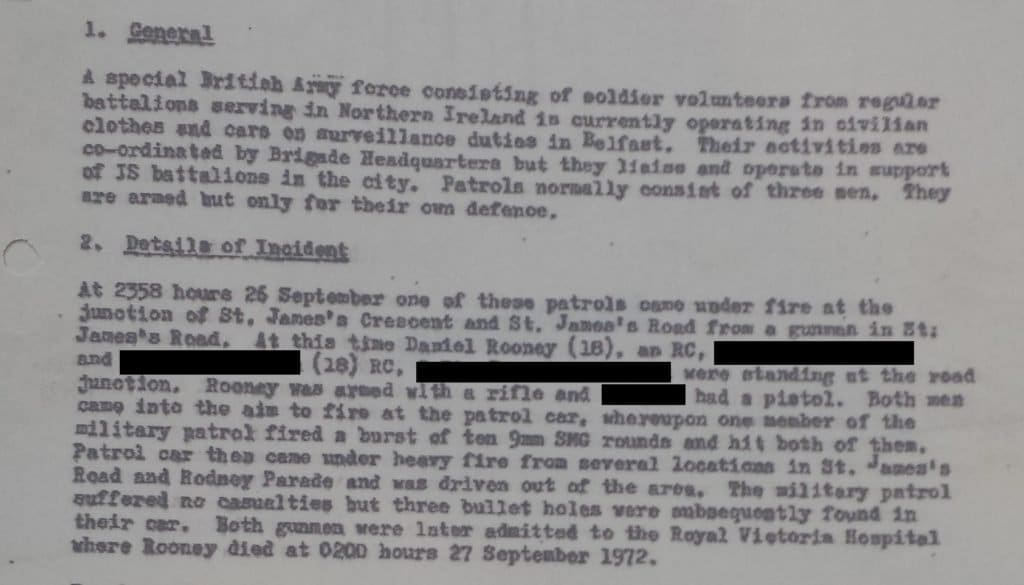
A later Ministry of Defence file prepared for the MOD’s legal defence team in July 1975 records that the undercover unit was operating as a Mobile Surveillance Patrol.

BBC Panorama in 2013 examined Daniel Rooney’s killing as an MRF shooting and an “object of interest” was discovered when his body was exhumed in 2016. As well as this new evidence, Paper Trail can provide the details of closed, contemporaneous logs which will help the families’ legal representatives in this particular case and may help clarify whether the shooting was perpetrated by the MRF as inferred by the former document or a surveillance unit of the resident British Army battalion, the 3rd Battalion of the Royal Green Jackets.
- 15th April 1972 – Conway brothers shot
This document is from a Watchkeeper Log of the Kings Own Scottish Borderers which was discovered by James Kinchin-White. It confirms that a quick reaction undercover unit of KOSB led by Lt. Julian Tony Ball attacked the civilian Conway brothers.
This incident has been mistaken for an MRF attack although Ball’s covert unit acted in a similar way and with impunity.
The archive proves that the quick reaction unit deployed when an RUC officer allegedly sighted local IRA leader, Jim Bryson, early in the morning.
It was not Bryson, though.
Instead, the undercover KOSB unit attacked and shot two unarmed brothers on their way to work.
The KOSB unit allege that they were shot at by Bryson and recovered a Star pistol. Local residents refuted all of this and the retrieval of a weapon disappeared from the narrative when the British Army realised that it had targeted civilians and not IRA volunteers.
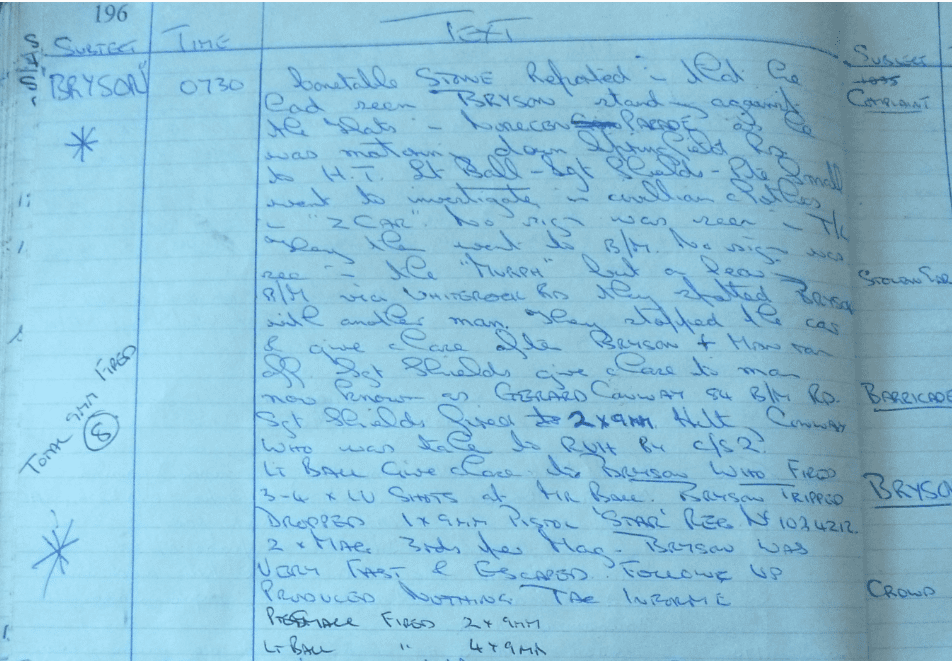
Summary Conclusion
These archives prove that all but one incident involved the MRF or an undercover quick reaction unit of the resident British Army battalion acting in a similar role.
The incident which did not involve a named MRF unit, involved a quick reaction unit within the King’s Own Scottish Borderers which was in plain clothes, in an unmarked car and operated in a similar way to the MRF.
Not only did this unit injure two civilians in a botched assassination or arrest attempt (depending on your own reading of the unit’s actions), but also recorded the discovery of a gun at the scene which subsequently disappeared from any investigation (which was, by any standard, limited).
This leads us to one of two conclusions: (1) that the gun (a Star 9mm, serial number 1034212) was planted by the British military unit and then removed when the would-be assassins realised they had shot the unarmed brothers; or (2) was removed to avoid proper scrutiny of – or disciplinary action against – the covert unit for not following Yellow Card Rules of Engagement and shooting unarmed civilians.
These incidents left two civilians dead and 16 injured including a 15-year-old boy. A further victim is recorded in the archives but not on the LIB list. The MRF could have killed or injured many more civilians in these particular attacks.
Witnesses in each of these incidents contest the reports by the British military that the British soldiers were shot at or were in fear for their lives when the victims were shot. Local residents did accost a unit after the shooting in Silvio Street, it appears.
These archives illustrate how covert British military units were shooting and killing people at the same time as Jean’s murder and in the same area. The archives represent the British military’s reporting of the incidents but the circumstances are completely disputed by civilian witnesses and surviving victims in each case.
In some cases, the British military released information to the media which conflicted with its own records, including allegations that paramilitaries were guilty of the attacks when it knew its soldiers were involved.
Furthermore, none of these victims were ever convicted of any shooting incident alleged by the MRF and, of course, the PSNI says it is investigating the MRF’s actions in each case.
In fact, the archives prove that the Glen Road where Jean was killed and the surrounding locale under 2 Field Regiment control was a macabre hunting ground for MRF during 2 FD’s tour of duty. 4 civilians were shot in the exact area where Jean was killed. The Military Reaction Force shot a number of other civilians along that same stretch of road.
Paper Trail has given police investigators the details of the closed British military logs which could prove whether the MRF was indeed also guilty of Jean’s murder and we await their retrieval.
In the meantime, our research of the Operation Everson list of cases exposes not only the modus operandi of Britain’s killer gang, the Military Reaction Force, but also the continued failure of the Legacy Investigation Branch to bring the killers to justice.
There are no “vexatious claims” or “witchhunts” here, just evidence from the British Army’s own secret files.
The British Ministry of Defence may continue “to deny that any soldiers are operating in Northern Ireland in plain clothes as ‘assassination squads'” just as it did below in a high-level meeting NIO/MOD meeting on 2nd June 1972, but archives in our possession show it discussed expanding the role and activities of the Military Reaction Force the following month.

Whilst it may be difficult to imagine that the British state and its police would sanction a covert British military unit to shoot and kill unarmed civilians on the streets of Bradford or Bristol, they did exactly this in Belfast; and the police – past and present – have failed the civilian victims.
Further Information
Read some of our other research into the activities of the MRF here or download Trope: Essays and Articles by Ciarán MacAirt
James Kinchin-White also publishes his work in collaboration with author, Ed Maloney. Read some of it here.
Download Margaret Urwin’s Countergangs via Justice for the Forgotten/Pat Finucane Centre.

Ciarán MacAirt is founder and manager of the charity, Paper Trail. He is author of the critically acclaimed book, The McGurk’s Bar Bombing. His new book, Trope: Essays and Articles, is now available on Kindle, with all proceeds going to Paper Trail to help other families in their pursuit of truth.

